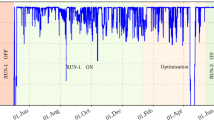Abstract
The rate of neutrino- and antineutrino-induced prompt same-sign dimuon production in steel was measured using a sample of μ−μ− events and 25 μ+μ+ events withP μ>9 GeV/c, produced in 1.5 millionv μ and 0.3 million\(\overline {v_\mu }\) induced charged-current events with energies between 30 GeV and 600 GeV. The data were obtained with the Chicago-Columbia-Fermilab-Rochester (CCFR) neutrino detector in the Fermilab Tevatron Quadrupole Triplet Neutrino Beam during experiments E 744 and E 770. After background subtraction, the prompt rate of same-sign dimuon production is (0.53±0.24)×10−4 perv μ charged-current event and (0.52±0.33)×10−4 per\(\overline {v_\mu }\) charged-current event. The kinematic distributions of the same-sign dimuon events after background subtraction are consistent with those of the non-prompt background due to meson decays in the hadron shower of a charged-current event. Calculations ofc \(\bar c\) gluon bremsstrahlung, based on improved measurements of the charm mass parameter and nucleon structure functions by the CCFR collaboration, yield a prompt rate of (0.09±0.39)×10−4 perv μ charged-current event. In this case,c \(\bar c\) gluon bremsstrahlung is probably not an observable source of prompt same-sign dimuons.
Similar content being viewed by others
References
J.R. Cudell, F. Halzen, K. Hikasa: Phys. Lett. B 175 (1986) 227
V. Barger, W.Y. Keung, R.J.N. Phillips: Phys. Rev. D 24 (1981) 244
K. Lang et al.: Z. Phys. C 33 (1987) 483
J.G.H. DeGroot et al.: Phys. Lett. 86B (1979) 103
M. Holder et al.: Phys. Lett. 70B (1977) 396
H. Burkhardt et al.: Z. Phys. C 31 (1985) 39
M. Jonker et al.: Phys. Lett. 107B (1981) 241
T. Trinko et al.: Phys. Rev. D 23 (1981) 1889
K. Nishikawa et al.: Phys. Rev. Lett. 46 (1981) 1555
K. Nishikawa et al.: Phys. Rev. Lett. 54 (1985) 1336
B.A. Schumm et al.: Phys. Rev. Lett. 60 (1988) 1618
P.H. Sandler: Ph.D. Thesis. University of Wisconsin-Madison 1992
W.K. Sakumoto et al.: Nucl. Instrum. Methods A 294 (1990) 179
F.S. Merritt et al.: Nucl. Instrum. Methods A 245 (1986) 27
S.R. Mishra et al.: Phys. Rev. Lett. 63 (1989) 132
B.A. Schumm: Ph.D. Thesis. University of Chicago 1988
B.J. King et al.: Nucl. Instrum. Methods A 302 (1991) 254
S.R. Mishra et al.: Measurements of nucleon structure functions... (1992) (submitted for publication to Phys. Rev. Lett.)
Review of Particle Properties. Physics Letters B 239 (1990)
P.H. Sandler et al.: Phys. Rev. D 42 (1990) 761
T. Sjöstrand: Comput. Phys. Commun. 27 (1982) 243
D. Allasia et al.: Z. Phys. C 24 (1984) 119; H. Deden et al.: Nucl. Phys. B 198 (1982) 365; N.J. Baker et al.: Phys. Rev. D 34 (1986) 1251
A. Arvidson et al.: Nucl. Phys. B 246 (1984) 381; M. Arneodo et al.: Phys. Lett. 145B (1984) 156
N. Angelov et al.: Yad. Fiz. 25 (1977) 1013; Sov. J. Nucl. Phys. 25 (1977) 539
W. Busza: Nucl. Phys. A 418 (1984) 635
F.W. Brasse et al.: Proceedings of the 20th International Conference of High Energy Physics. 1980, p. 755
K.J. Anderson et al.: Phys. Rev. Lett. 37 (1976) 799
V. Barger, T. Gottschalk, R.J.N. Phillips: Phys. Rev. D 17 (1977) 2284
This cut on the momentum of the least energetic muon for the identified trimuon events was chosen to minimize trimuons from meson-decays in the hadron shower of opposite-sign dimuon events
V. Barger, W.Y. Keung, R.J.N. Phillips: Phys. Rev. D 25 (1982) 1803
M.H. Shaevitz: Nucl. Phys. B (Proc. Suppl.) 19 (1991) 270
W.C. Leung: Ph.D. Thesis. Columbia University 1991
C. Peterson et al.: Phys. Rev. D 27 (1983) 105
H. Albrecht et al.: Phys. Lett. 105B (1985) 235
P.Z. Quintas et al.: A measurement of\(\Lambda _{\overline {MS} }\) fromv μ structure functions at the Fermilab Tevatron. (1992) (submitted for publication to Phys. Rev. Lett.)
V. Barger (Private Communication, 1992)
Eadie et al.: Statistical methods in experimental physics, pp. 269–270. Amsterdam: North-Holland 1971
C. Foudas: Ph.D. Thesis, Columbia University 1989
J.C. Anjos et al.: Phys. Rev. Lett. 60 (1988), 1239
V. Jain et al.: Phys. Rev. D 41 (1990) 2057
A. Benvenuti et al.: Phys. Rev. Lett. 35 (1975) 1199
Author information
Authors and Affiliations
Rights and permissions
About this article
Cite this article
Sandler, P.H., Kinnel, T.S., Smith, W.H. et al. Neutrino production of same-sign dimuons at the Fermilab Tevatron. Z. Phys. C - Particles and Fields 57, 1–12 (1993). https://doi.org/10.1007/BF01555733
Received:
Issue Date:
DOI: https://doi.org/10.1007/BF01555733




